Photos
The photographs on this page show many of the receivers in my personal collection. I am missing some receivers that I'd dearly love to own though they cost a fortune in second hand shops. Over the last few years I have mainly only taken possession of sets that have been given to me, though the first one below was acquired for $140 from Burning Mountain Antique Centre at Wingen, NSW. Any set made by AWA is worth having in any respectable collection, this one is no exception.
Fisk Radiola
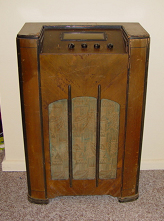
This AWA Radiola, actually a Fisk Radiola by it's badging on the tuning condenser was made in 1936 and has the typical valve compliment of the time: 80, 42, 6A7, 6D6, 6B7. Some people choose not to include the rectifier as part of a receiver's valve lineup, though it is a valve and without it the rest of the radio is unusable, so I choose to go with the mainstream and include it. Valves are also called tubes in some countries though I will always refer to them as valves because thay is what they really are.
On the chassis of this receiver there is a blanked-off spot for a second type 42 which is an output apmplifier. Most often, thouh not always, when output valves worked in pairs they were connected in what is known as 'push-pull' mode rather than in parallel mode. I am not convinced that one method is better than the other though most would probably say that push-pull works better. There'd certainly not be much audible difference as both methods would provide a hell of an improvement to volume and depth of the sound. By the way, the grille cloth is not the original. AWA wasn't known for producing sets with brightly coloured grille cloths. When I get around to restoring this set I will make sure a more appropriate cloth is included.
More often than not, the five valve lineup in a receiver was the agreed balance between price and quality. Most mantel models, pictured to the side and in some cases below, only had four valves. More on that later. When a set was equipped with a second output valve it was like a car of the period equipped with more than three foward gears, meaning that the radio was something special. It came with a special price tag too. The most expensive items in a receiver were the valves. A set like this would set a buyer back around 15 weeks wages.
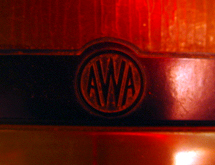
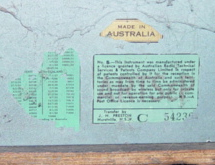
Notes: The AWA logo is synonymous with Australia's broadcasting past. AWA still exists today as a manufacturer of totalisator and gaming equipment. The picture on the right shows two transfers with the left showing the list of patents applying to the receiver and the one on the right is the licence from the Postmaster General's Department. Without this it was illegal to own or listen to a receiver. The "C" prefix on the serial number indicates that the set was made in 1936.
Valve powered walkman?
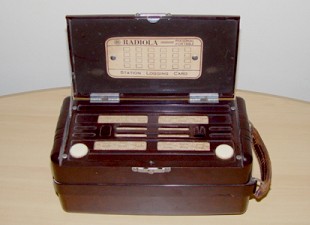
Did Sony invent the Walkman? I'd say not, though they did give the device a catchy name. The title of the inventor of the walkman style portable radio, in my humble opinion, belongs to AWA. This one was made in the late 1950's and with the help of the minature baseless valves available at the time, some of which were no bigger than a grape, receivers were able to be condensed into quite small packages.
There are a few things to remember here. The first is that the set is still made of formaldehyde based bakelite. This stuff doesn't bounce too well, so portable sets still had to be treated with the utmost respect. These receivers were considered luxuries and a premium price tag was always attached. They ran on batteries, but not the sort we use today. Battery powered valve sets required at least two supplies of power, sometimes three. In the case of this portable, two were required: an 'A' battery for the valve filaments and this was usually 4 volts, and a 'B' battery which was 63 volts and this ran the high tension side of the circuit. This battery (which is made using seven of the small 9 volt transistor batteries) is capable of giving you a 'belt' if you have sweaty fingers so keep the fingers away from the terminals. I made the 'A' battery from two C size cells. While this only comes to three volts, it is strong enough to bring in local staions at reasonable volume and goes some way to helping preserve the delicate filaments in these valves.
I have to say that I love this receiver alot. I rarely listen to it because the batteries only last a few hours and then they require replacing. The batteries available at the time the receiver was made would have served the set's owner slightly better though they would have just about bankrupted them. Batteries were very expensive at the time. This portable receiver measures roughly 200mm x 100mm x 100mm.
The 1920's

This would have to be the most valuable receiver in my collection. These coffin shaped sets pioneered the commercialisation of wireless manufacturing. Before that people made crystal sets themselves and listened in on bakelite headphones which had very tinny sound quality. This King, made by the Buffalo Radio Co. New York, is an American set and considered very rare in Australia. It has a Marviplate front panel, whereas most Australian sets of the 1920's were all wooden, though many were 'trimmed' with brass, baked enamel and polished fibre panels too. For those that don't know, Marviplate is a piece of sheet steel with a woodgrain finish painted on in a similar way to the 'Colourbond' steel used in Australian fences and roofing.
I still have some learning to do as far as these very rare and early receivers are concerned though I do know that there are six valves in the lineup and they were a mix of 200's 201's and 301's. The filaments were rated at 5 volts and tended to have very short lives if they were fed anything higher. The 5 volt supply came from a 6 volt 'A' battery with a voltage dropping resister in series with the filaments. The 'B' battery was 90 volts. This voltage is high enough to give you a shock or produce a hefty spark if the terminals are shorted. There was also a 'C' battery in these early receivers and this was rated at 9 volts and provided a bias voltage for the screen grids in the valves.
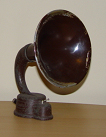
Tuning one of these sets was a skill in itself. You needed a solid earth connection, a high aerial and steady fingers to operate the two tuning knobs. Some of these sets had three tuning controls! Normally you'd use headphones to listen in, but these quickly gave way to horn speakers, as pictured to the left. These sounded dreadful because they had no bass response at all. They sounded like someone speaking through a sheet of aluminium foil. At the time though this was all people had and the paper cone speakers we listen to today were still another 10 years away.
People have been known to 'see if she works' when they get hold of these things. This is fine if you connect them only to the radios that they were designed for. Please DO NOT ever connect these speakers to transistorised sets. You will burn out the delicate field windings if you do and finding wire of the correct gauge to perform a rewind is not easy. These speakers are truly part of the beginnings of radio broadcasting around the world. If you acquire one, treasure it or sell/give it to a collector who will usually not let temptation get the better of him. This particular speaker pictured consists of a cast iron base with a stamped aluminium horn. The brand is 'Brown' and most likely explains the colour it was painted by the manufacturer. Horn speakers came in many shapes and sizes and the most famous horn of all were the Amplion 'Morning Glories' which had wooden petals that made up the horn shape. All these speakers are very well sought after by collectors.

Sign In

Vintage Radio and Television is proudly brought to you by an era where things were built with pride and made to last.
DISCLAIMER: Valve radios and televisions contain voltages that can deliver lethal shocks. You should not attempt to work on a valve radio or other electrical appliances unless you know exactly what you are doing and have gained some experience with electronics and working around high voltages. The owner, administrators and staff of Vintage Radio & Television will accept no liability for any damage, injury or loss of life that comes as a result of your use or mis-use of information on this website. Please read our Safety Warning before using this website.
WARNING: Under no circumstances should you ever apply power to a vintage radio, television or other electrical appliance you have acquired without first having it checked and serviced by an experienced person. Also, at no time should any appliance be connected to an electricity supply if the power cord is damaged. If in doubt, do not apply power.
Shintara - Keepin' It Real · VileSilencer - Maintain The Rage
